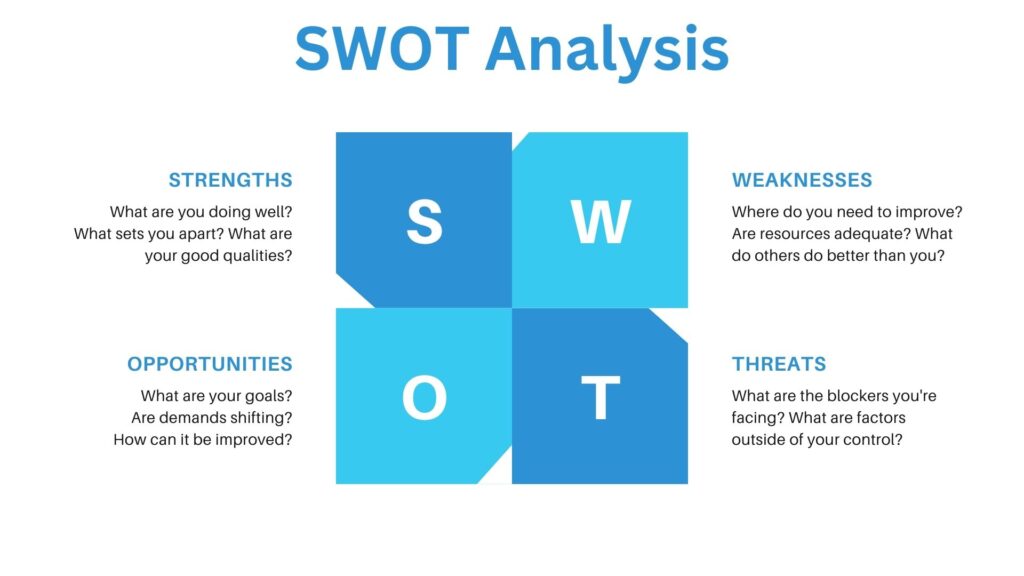As an entrepreneur and digital marketer with over a decade of experience, I’ve seen countless businesses rise and fall.
What separates the successes from the failures?
More often than not, it’s the ability to make informed decisions and solve problems effectively.
That’s where SWOT Analysis comes in – a powerful tool that has been my secret weapon in navigating the turbulent waters of business strategy.
Imagine having a crystal ball that could show you your business’s strengths, weaknesses, opportunities, and threats all at once. Sounds magical, right? Well, SWOT Analysis isn’t magic, but it’s pretty close. It’s a strategic planning technique that can help you make smarter choices, avoid pitfalls, and uncover hidden opportunities.
In this deep dive, we’ll explore the ins and outs of SWOT Analysis, from its basic principles to advanced applications.
What is SWOT Analysis?
SWOT Analysis is like a Swiss Army knife for your business strategy. It’s a simple yet powerful framework that helps you identify your organization’s Strengths, Weaknesses, Opportunities, and Threats. But don’t let its simplicity fool you – when used correctly, SWOT can provide profound insights that drive real change.
I first encountered SWOT Analysis early in my career when I was struggling to figure out why my fledgling e-commerce business wasn’t taking off. A mentor suggested I try this technique, and it was like turning on a light in a dark room. Suddenly, I could see clearly where I was excelling, where I was falling short, and what external factors were influencing my success.
At its core, SWOT Analysis is about taking an honest, 360-degree look at your business or project. It forces you to confront uncomfortable truths and challenge your assumptions. But it’s not all about finding flaws – it’s equally about recognizing your unique advantages and spotting potential opportunities on the horizon.
The beauty of SWOT lies in its versatility. I’ve used it for everything from launching new products to deciding whether to pivot my entire business model. It’s equally valuable for Fortune 500 companies and solo entrepreneurs, for-profit businesses, and non-profit organizations.
So, SWOT Analysis can be your compass, whether you’re trying to outmaneuver competitors, navigate a changing market, or simply improve your personal performance. It’s not about predicting the future but equipping yourself with the insights to shape it.

The Four Elements of SWOT Analysis
Let’s break down the SWOT acronym and explore each element in depth:
Strengths
These are the internal factors that give your organization an edge over others. Think of them as your secret sauce, your unique selling points. In my experience, strengths often include:
- Unique skills or expertise
- Strong brand recognition
- Proprietary technology
- Solid financial resources
- Loyal customer base
Weaknesses
These are the internal factors that put you at a disadvantage. They’re the areas where you need improvement. Some common weaknesses I’ve encountered include:
- Lack of certain skills
- Limited resources
- Poor brand awareness
- Outdated technology
- High employee turnover
Opportunities
These are external factors that you could leverage to your advantage. They’re the potential areas for growth and improvement. Opportunities might include:
- Emerging markets
- Changes in technology
- Shifts in consumer behavior
- New partnerships
- Competitors’ weaknesses
Threats
These are external factors that could potentially harm your organization. They’re the obstacles you need to overcome or mitigate. Common threats include:
- New competitors
- Changing regulations
- Economic downturns
- Negative press
- Shifts in customer preferences
Remember, what’s a strength for one organization might be a weakness for another. And what’s an opportunity today might become a threat tomorrow. That’s why it’s crucial to conduct SWOT analyses regularly and keep your finger on the pulse of your industry.
SWOT Analysis for Your Project
Strengths
Weaknesses
Opportunities
Threats
How to Conduct a SWOT Analysis
Conducting a SWOT Analysis isn’t rocket science, but it does require careful thought and honesty. Here’s the step-by-step process I use:
- Gather the right people: Include team members from different departments to get diverse perspectives.
- Brainstorm strengths: Start with the positives. What do you do better than anyone else?
- Identify weaknesses: Be brutally honest. What areas need improvement?
- Spot opportunities: Look at industry trends, market changes, and competitor activities.
- Recognize threats: Consider external factors that could negatively impact your business.
- Prioritize and analyze: Not all points are equally important. Rank them and focus on the most critical ones.
- Develop strategies: Use the insights to create actionable plans. How can you leverage strengths and opportunities while addressing weaknesses and threats?
- Review and update: SWOT Analysis isn’t a one-and-done exercise. Revisit and update it regularly.
Pro tip: Use a simple 2×2 grid to visualize your SWOT Analysis. It helps in seeing the big picture and spotting connections between different elements.
SWOT Analysis in Action: Real-World Examples
Let’s look at how SWOT Analysis has been used effectively in real business scenarios:
Example 1: Netflix
When Netflix was transitioning from DVD rentals to streaming, they likely conducted a SWOT Analysis that looked something like this:
- Strengths: Strong brand, large customer base, technology infrastructure
- Weaknesses: Reliance on licensing content from other studios
- Opportunities: Growing demand for on-demand content, international markets
- Threats: Potential loss of licensed content, new streaming competitors
Netflix leveraged its strengths and opportunities by investing heavily in original content production and international expansion, effectively addressing its weaknesses and threats.
Example 2: Small Local Bakery
I once helped a local bakery conduct a SWOT Analysis:
- Strengths: High-quality, unique recipes; loyal local customer base
- Weaknesses: Limited marketing budget, small production capacity
- Opportunities: A growing trend of artisanal, locally sourced food
- Threats: Large chain bakeries moving into the area
Based on this analysis, we developed a strategy to focus on the bakery’s unique offerings, leveraged social media for cost-effective marketing, and explored partnerships with local cafes to expand reach without increasing production capacity.
These examples show how SWOT Analysis can be applied to businesses of all sizes and industries, providing valuable insights for strategic decision-making.
Common Pitfalls and How to Avoid Them
In my years of using and teaching SWOT Analysis, I’ve seen people fall into the same traps over and over. Here are some common pitfalls and how to sidestep them:
- Being too vague: Saying “good quality” as a strength doesn’t tell you much. Be specific: “Consistently rated 5 stars for product durability.”
- Ignoring external input: Your perspective might be biased. Gather input from customers, employees, and even competitors if possible.
- Focusing only on the present: SWOT should consider future trends too. What strengths might become obsolete? What emerging technologies could become opportunities?
- Treating SWOT as a one-time exercise: The business landscape changes rapidly. Make SWOT Analysis a regular part of your strategic planning.
- Not prioritizing: Not all factors carry equal weight. Rank your SWOT elements to focus on what truly matters.
- Stopping at analysis: SWOT is just the beginning. The real value comes from developing and implementing strategies based on your findings.
- Overlooking the connections: The real insights often come from how different SWOT elements interact. A strength could help you capitalize on an opportunity, or a weakness could make you vulnerable to a threat.
By avoiding these pitfalls, you can ensure your SWOT Analysis provides meaningful, actionable insights rather than just a list of obvious facts.
Advanced SWOT Techniques
Once you’ve mastered the basics of SWOT Analysis, you can take it to the next level with these advanced techniques:
- Weighted SWOT: Assign a weight to each factor based on its importance. This helps in prioritizing your strategies.
- Quantitative SWOT: Use data and metrics to back up your SWOT factors. For example, instead of just listing “strong market share” as a strength, specify “35% market share, leading the industry.”
- Dynamic SWOT: Create multiple SWOT analyses for different time frames – current, 1 year from now, 5 years from now. This helps in long-term strategic planning.
- Competitor SWOT: Conduct a SWOT analysis for your main competitors. This can reveal opportunities to exploit their weaknesses or threats you hadn’t considered.
- SWOT Matrix: Create strategies by matching different SWOT elements. For example, how can you use a strength to capitalize on an opportunity?
- Scenario SWOT: Develop multiple SWOT analyses based on different future scenarios. This helps in contingency planning.
- SWOT in Reverse: Start with your goals and work backward. What strengths do you need to develop? What weaknesses do you need to address?
These advanced techniques can help you squeeze even more value out of your SWOT Analysis, providing deeper insights and more robust strategies.
SWOT Analysis vs. Other Strategic Tools
While SWOT Analysis is incredibly useful, it’s not the only tool in the strategic planning toolbox. Let’s compare it with some other popular methods:
| Tool | Focus | Strengths | Limitations |
|---|---|---|---|
| SWOT Analysis | Internal and external factors | Good for understanding the broader context | Can be subjective |
| PEST Analysis | External macro-environment factors | Deep dive into the competitive landscape | Doesn’t consider internal factors |
| Porter’s Five Forces | Industry competition | Deep dive into competitive landscape | Focuses mainly on threats |
| Balanced Scorecard | Performance measurement | Links strategy to operations | Complex to implement |
| BCG Matrix | Product portfolio analysis | Helps in resource allocation | Oversimplifies market dynamics |
In my experience, SWOT Analysis shines in its simplicity and versatility. It provides a good starting point for deeper analysis. However, for the best results, I often use SWOT in combination with other tools. For instance, I might use PEST Analysis to inform the Opportunities and Threats sections of my SWOT, or use the insights from a SWOT Analysis to develop a Balanced Scorecard.
Remember, these tools are not mutually exclusive. The key is to choose the right tool or combination of tools for your specific situation and needs.
Integrating SWOT into Your Decision-Making Process
SWOT Analysis isn’t just a standalone exercise – it can and should be integrated into your broader decision-making process. Here’s how I’ve successfully incorporated SWOT into my strategic planning:
- Regular SWOT reviews: Conduct a full SWOT Analysis quarterly or bi-annually. This keeps you attuned to changes in your business environment.
- SWOT before big decisions: Whenever you’re facing a major decision – entering a new market, launching a product, making a large investment – start with a SWOT Analysis.
- SWOT in team meetings: Encourage team members to think in SWOT terms during brainstorming sessions. This helps in identifying potential issues and opportunities early.
- SWOT-driven KPIs: Use your SWOT Analysis to inform your Key Performance Indicators (KPIs). For example, if a particular weakness is identified, create a KPI to track improvement in that area.
- SWOT in risk management: Use the Threats section of your SWOT to inform your risk management strategies.
- SWOT for personal development: Encourage team members to create personal SWOT analyses as part of their professional development plans.
By weaving SWOT Analysis into the fabric of your decision-making processes, you create a culture of strategic thinking that can drive continuous improvement and innovation.
The Psychology Behind SWOT Analysis
As a tool that requires self-reflection and honest assessment, SWOT Analysis taps into some interesting psychological principles:
- Cognitive Bias: We all have blind spots. SWOT helps overcome these by forcing us to consider multiple perspectives.
- Confirmation Bias: There’s a tendency to focus on information that confirms our pre-existing beliefs. SWOT’s structured approach helps counteract this.
- Negativity Bias: Humans naturally give more weight to negative information. SWOT balances this by equally considering positives (Strengths and Opportunities).
- Overconfidence Effect: Many leaders overestimate their strengths. SWOT’s inclusion of Weaknesses helps temper this.
- Availability Heuristic: We tend to overemphasize recent or easily remembered information. SWOT’s comprehensive approach helps overcome this.
Understanding these psychological aspects can help you conduct more objective and insightful SWOT analyses. It’s about training your mind to see the full picture, not just what you want or expect to see.
SWOT Analysis in the Digital Age
In today’s fast-paced digital world, SWOT Analysis has evolved to meet new challenges:
- Real-time SWOT: With the wealth of data available, some companies are moving towards continuous SWOT Analysis, updating in real-time as market conditions change.
- AI-powered SWOT: Artificial Intelligence can help gather and analyze data for SWOT, providing more objective and data-driven insights.
- Digital Strengths and Weaknesses: In the digital age, factors like website performance, social media presence, and data security become crucial elements of a SWOT Analysis.
- Global Perspective: Digital tools make it easier to gather insights from global markets, making SWOT Analysis more comprehensive for international businesses.
- Collaborative SWOT: Cloud-based tools allow teams to collaborate on SWOT Analysis in real-time, even when working remotely.
- SWOT for Digital Transformation: Many businesses are using SWOT to guide their digital transformation efforts, assessing their readiness for new technologies.
As we navigate the digital landscape, SWOT Analysis remains a valuable tool, adapting to new realities while maintaining its core principles.
Measuring the Impact of Your SWOT Analysis
It’s one thing to conduct a SWOT Analysis, but how do you know if it’s actually making a difference? Here are some ways to measure the impact:
- Track Implementation: Monitor how many strategies developed from your SWOT Analysis are actually implemented.
- Before and After Metrics: Measure relevant KPIs before and after implementing SWOT-driven strategies.
- Decision Quality: Assess whether decisions made using SWOT insights lead to better outcomes.
- Team Alignment: Survey team members to see if SWOT Analysis has improved understanding of the company’s position and strategy.
- Competitive Position: Monitor changes in market share or competitive advantage after applying SWOT insights.
- Risk Mitigation: Track how effectively you’ve been able to address identified threats.
- Opportunity Capitalization: Measure success in leveraging identified opportunities.
Remember, the true value of SWOT Analysis lies not in the analysis itself, but in the actions it inspires and the results those actions produce.
SWOT Analysis for Personal Development
While we often think of SWOT Analysis in a business context, it’s also a powerful tool for personal growth. I’ve used it myself and recommended it to many mentees. Here’s how to apply SWOT to your personal development:
- Strengths: What are you naturally good at? What skills have you developed? What do others praise you for?
- Weaknesses: What tasks do you struggle with? What feedback have you received about areas for improvement?
- Opportunities: What trends in your industry could you capitalize on? Are there new roles or responsibilities you could take on?
- Threats: What obstacles might prevent you from achieving your goals? Are there external factors that could negatively impact your career?
By conducting a personal SWOT Analysis, you can create a targeted personal development plan that builds on your strengths, addresses your weaknesses, capitalizes on opportunities, and mitigates potential threats to your success.
The Future of SWOT Analysis
As we look ahead, SWOT Analysis is likely to evolve in several exciting ways:
- AI Integration: Artificial Intelligence will play a bigger role in conducting SWOT analyses, providing more data-driven insights and reducing human bias.
- Predictive SWOT: Advanced analytics will allow for more accurate predictions of future strengths, weaknesses, opportunities, and threats.
- Dynamic SWOT: Instead of static analyses, we’ll see more real-time, continuously updated SWOT dashboards.
- Sustainability Focus: As environmental and social concerns become more pressing, SWOT analyses will increasingly incorporate sustainability factors.
- Crowd-Sourced SWOT: Companies may leverage their customers and wider stakeholder groups to contribute to SWOT analyses, providing more diverse perspectives.
- Virtual and Augmented Reality: These technologies could provide new ways to visualize and interact with SWOT data.
- Integration with Other Tools: We’ll likely see tighter integration between SWOT and other strategic planning and business intelligence tools.
The core principles of SWOT Analysis will remain relevant, but the way we conduct and use these analyses will continue to evolve with technology and changing business needs.
TL;DR Summary
SWOT Analysis is a powerful strategic planning tool that helps identify Strengths, Weaknesses, Opportunities, and Threats. It provides a comprehensive view of an organization’s internal and external factors, aiding in decision-making and problem-solving. Key points to remember:
- SWOT is versatile and can be applied to businesses, projects, and personal development.
- It requires honest assessment and diverse input for best results.
- Common pitfalls include being too vague, ignoring external input, and not prioritizing findings.
- Advanced techniques like Weighted SWOT and SWOT Matrix can provide deeper insights.
- SWOT should be integrated into regular decision-making processes for maximum benefit.
- The future of SWOT includes AI integration, real-time analysis, and sustainability focus.
When used effectively, SWOT Analysis can be a game-changer in strategic planning and personal growth.
Q&A Section
Q1: How often should a SWOT Analysis be conducted?
A1: For most businesses, conducting a SWOT Analysis quarterly or bi-annually is a good practice. However, it’s also wise to perform a SWOT Analysis before major decisions or in response to significant market changes.
Q2: Can SWOT Analysis be used for personal development?
A2: Absolutely! SWOT Analysis can be a powerful tool for personal growth, helping individuals identify their strengths, weaknesses, opportunities for growth, and potential obstacles to success.
Q3: What’s the difference between SWOT and PEST Analysis?
A3: While SWOT Analysis looks at both internal (Strengths and Weaknesses) and external (Opportunities and Threats) factors, PEST Analysis focuses solely on external factors: Political, Economic, Social, and Technological.
Q4: How can I ensure my SWOT Analysis is objective?
A4: To increase objectivity, gather input from diverse sources, including team members, customers, and external experts. Use data to support your points where possible, and be willing to challenge your own assumptions.
Q5: Is SWOT Analysis only for large businesses?
A5: Not at all! SWOT Analysis can be beneficial for businesses and projects of all sizes, from solo entrepreneurs to multinational corporations. The key is to tailor the depth and scope of the analysis to your needs.
SWOT Analysis Quiz
Test your understanding of SWOT Analysis with this quick quiz:
- The ‘S’ in SWOT stands for: a) Strategy b) Strengths c) Systems d) Solutions
- Which of these is an internal factor in SWOT Analysis? a) Market trends b) Competitor actions c) Skilled workforce d) New technologies
- SWOT Analysis is typically represented as: a) A pie chart b) A 2×2 grid c) A line graph d) A pyramid
- Which of these is NOT a common pitfall in SWOT Analysis? a) Being too vague b) Ignoring external input c) Conducting it too frequently d) Stopping at analysis without action
- In a personal SWOT Analysis, which category might “Strong public speaking skills” fall under? a) Strength b) Weakness c) Opportunity d) Threat
Answers:
- b) Strengths
- c) Skilled workforce
- b) A 2×2 grid
- c) Conducting it too frequently
- a) Strength
Scoring:
- 5 correct: You’re a SWOT superstar!
- 3-4 correct: Great understanding of SWOT basics.
- 1-2 correct: You’re on the right track, but might want to review the concept.
- 0 correct: Time to dive back into the article and strengthen your SWOT knowledge!
Remember, understanding SWOT Analysis is just the first step. The real power comes from applying it effectively to your business or personal development. Keep practicing, and you’ll soon be making more informed, strategic decisions!





